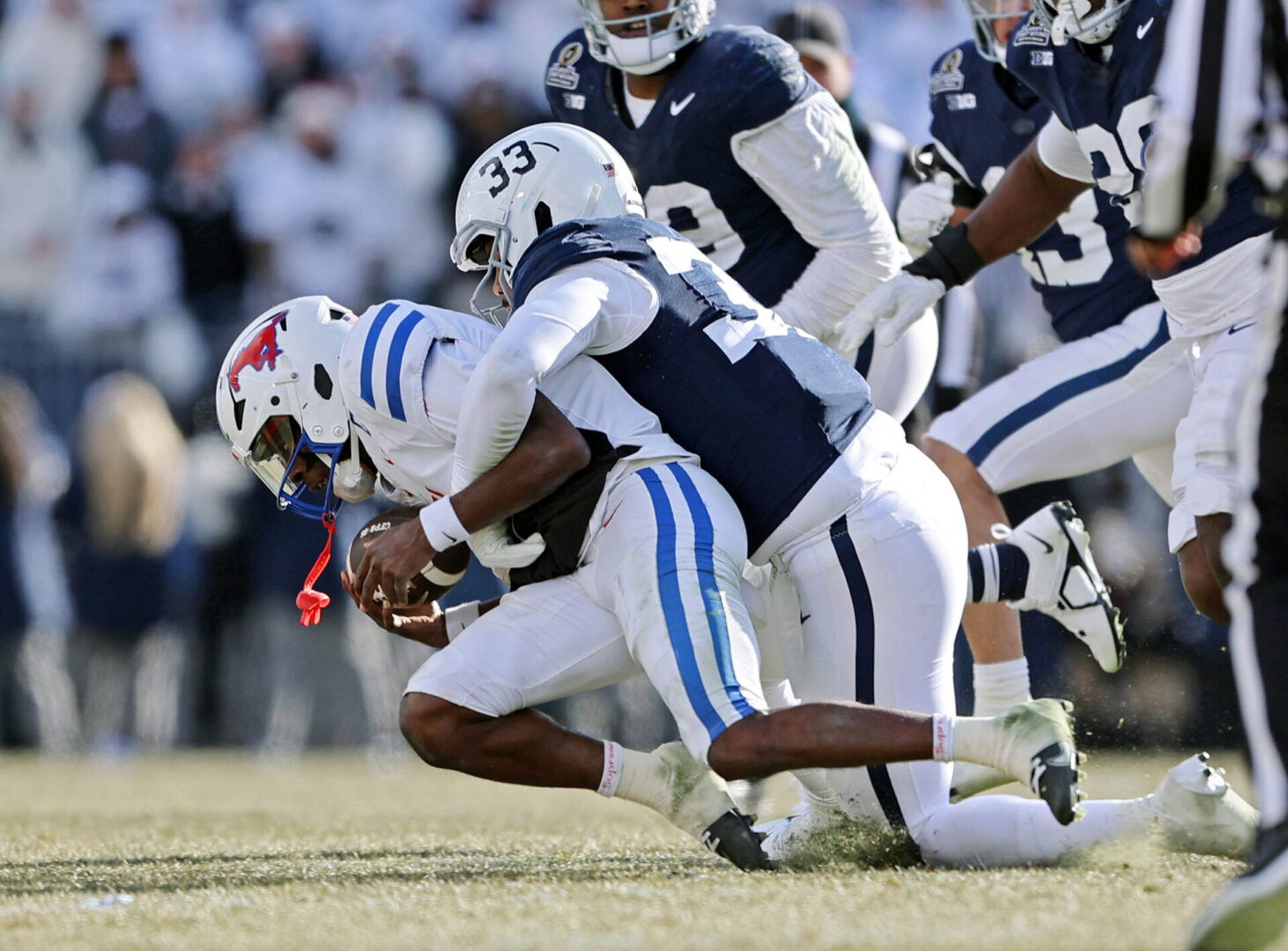The wind picked up with each climbing row, delivering a hard, frigid slap in the face. 106,000 bodies, heavily dressed in winter attire, pressed together. It was the first official day of winter, so it was only fitting that it had snowed, leaving a thin layer of frost along the green of Penn State’s Beaver Stadium. There, these fans stood, for hours, igniting a fire in the frosty, December breeze.
They roared as Dominic DeLuca took an interception into the end zone for a touchdown, and only grew louder when Tony Rojas did the same. Then they sang and danced as the final whistle blew, joyous to the completion of the Nittany Lions’ 38-10 victory over SMU in the first round of the College Football Playoff on Saturday.
It was cold, but it was everything Penn State and its fans had hoped for in the debut of a home playoff game: a packed White Out crowd, a dominating victory and a promising sign that James Franklin’s program is finally good enough to compete for a national championship in 2024.
“I remember in training camp, just talking to the guys about, like, I wanted these types of moments for them,” Franklin said postgame. “I want them to experience what it’s like to win a Big Ten Championship and play in that type of game and in that stadium and in that environment. Obviously, talk about battling like everybody in the country to try to either get a bye in Week 1 or a home game. We were able to do that.”
It began with a training camp that some players described as one of the most physical they’d ever experienced. Then came season-ending injuries to key players and another loss to Ohio State. But never have those bouts with adversity thrown off the Nittany Lions, who will face Boise State in the playoff’s quarterfinals on Dec. 31, just three wins from the national title.
The road has been long and treacherous, and for most it’s been years in the making. For Dvon J-Thomas, it’s been six years of Rose Bowl highs and COVID-season lows. But nothing to this point has compared to what will be the memory of Saturday. In his last collegiate home game, J-Thomas left the field he’d played on for six years a winner, a playoff winner.
“It meant the world, to be honest with you. I wanted to go out with a bang,” J-Thomas said. “I believe, truly believe, that we are the best defense in the country by far, by any means. And I think today was just another opportunity for us to show that. And there’s no other way that I wanted to go out of Beaver Stadium than to put on a performance, a defensive performance, like we did.”
It was an utterly dominant defensive performance. It included a pair of interceptions from DeLuca, another by Rojas, a touchdown from each of them, 11 tackles for loss, three sacks and seven quarterback hurries. There was nothing SMU quarterback Kevin Jennings — compared by Franklin to Lamar Jackson — could do. Penn State was relentless.
The final score read “blowout,” but without the Nittany Lions’ tantalizing defensive showcase carrying an offense that struggled for much of the game, it could’ve been anything but. For this reason, Andy Kotelnicki, the team’s high-energy offensive coordinator, gave credit to defensive coordinator Tom Allen in the postgame media room.
“Tom Allen, everybody!” Kotelnicki clapped toward Allen. “We didn’t even need to show up today.”
It was almost the complete opposite product from Penn State’s offense and defense than in its Big Ten title loss to Oregon on Dec. 7. On that day, Kotelnicki’s offense carried and Allen’s defense struggled. But that hardly matters now. Both coaches, who joined the program this past offseason, are coaching on the brightest stages they’ve ever experienced — and winning there.
“We weren’t playing in front of these crowds when we were in the Division III playoffs, even though at (Wisconsin) Whitewater we had tremendous support and had great crowds there,” said Kotelnicki, who coached at the Division II and III levels for eight years before landing a gig at Buffalo in 2015.
Allen’s been around major college football for nearly 15 years, including seven as the head coach at Indiana. But it’s unlikely he’s ever experienced anything quite like a playoff game at Beaver Stadium. And, for that matter, no one had until Saturday. Not even Franklin could’ve predicted what this novel game structure would look like.
The takeaway? It was cold. It was loud. It was windy. It was new. It was perfect.
“It just makes you really appreciate this experience that we’re all involved in right now,” Allen said. “To me, it’s about just not taking any of this for granted. We’re blessed to be at a place that values football at an extremely high level, that creates a lot of expectations, which is what you want. You want to be at a place that cares so much about winning and so much about being able to play at the highest level possible.”



